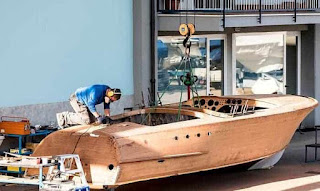Boat Building Wooden: Why Wood Remains a Superior Choice
For centuries, wood has been the material of choice for boat building, and for good reason. While modern materials like fiberglass and aluminum have gained popularity, wood continues to offer a unique combination of properties that make it a compelling option for experienced and aspiring boat builders alike. Its inherent beauty, coupled with its remarkable strength and workability, results in vessels that are not only functional but also aesthetically pleasing and, often, imbued with a timeless charm. This article delves into the reasons why wood remains a superior material for crafting exceptional boats.
The Enduring Strength and Resilience of Wood
Contrary to popular misconceptions, properly selected and treated wood possesses exceptional strength and durability, capable of withstanding the harsh marine environment. Hardwoods like oak, teak, and mahogany are renowned for their resistance to rot and decay, making them ideal for boat construction. These woods boast high tensile strength, meaning they can withstand significant pulling forces, crucial for a boat's structural integrity. Furthermore, wood's natural flexibility allows it to absorb impacts from waves and collisions more effectively than rigid materials, lessening the risk of catastrophic damage. Experienced boat builders know how to utilize wood's grain and natural properties to create incredibly strong and resilient hulls.
Understanding Wood Selection for Boat Building
The selection of wood is paramount. Different species offer varying degrees of strength, durability, and workability. For example:
- Teak is prized for its exceptional weather resistance and rich color.
- Oak offers incredible strength and is relatively easy to work with.
- Mahogany is known for its beauty, durability, and ease of carving.
Careful consideration of the wood's properties is essential to ensure the longevity and performance of the finished boat. A skilled boat builder will select the most appropriate species based on the boat's size, intended use, and the builder's specific needs.
The Art and Craft of Working with Wood
Wood's workability is another significant advantage. Unlike fiberglass or aluminum, wood allows for a level of customization and craftsmanship that is unparalleled. Experienced boat builders can shape and mold wood to create intricate designs and bespoke features, resulting in vessels that are truly unique. The process of shaping, joining, and finishing wood is a rewarding and deeply satisfying experience, fostering a strong connection between the builder and the boat itself. The tactile nature of working with wood offers a tangible sense of accomplishment not found in working with other materials.
The Beauty of a Handcrafted Wooden Boat
The aesthetic appeal of a wooden boat is undeniable. The natural beauty of the wood grain, the smooth curves of the hull, and the meticulously crafted details create a vessel that is both functional and a work of art. The warm tones and natural textures of wood evoke a sense of tradition and craftsmanship, transforming the boat into something more than mere transportation – it becomes a legacy piece, a testament to the skill and dedication of its builder. The enduring appeal of a wooden boat is a testament to the enduring beauty of handcrafted artistry.
The Sustainable Choice: Wood's Environmental Impact
Finally, and increasingly importantly, wood offers a more sustainable option compared to some other materials. Responsibly sourced wood from sustainably managed forests minimizes the environmental impact of boat building. Furthermore, wood is a renewable resource, meaning that with proper forestry practices, it can be replenished over time. This contrasts with materials like fiberglass, which often involves energy-intensive manufacturing processes and generates significant waste. Choosing wood represents a commitment to environmentally conscious boat building practices.










No comments:
Post a Comment